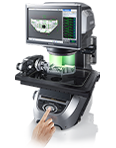Types of Errors
Errors in length are differences between the target's true value and the measured value, or between the reference value and the measured value. They are expressed as "error = measured value - true value." In actuality, it is difficult to obtain the true value no matter how precise the measurement is, so it is unavoidable that some uncertainty will exist in the measured value.
Errors can be classified into three major types according to the factor that generates the error. Such factors must be carefully considered to prevent errors.
(1) Systematic errors
With this type of error, the measured value is biased due to a specific cause. Examples include measurement variations resulting from differences between individual instruments (instrumental errors), temperature, and specific ways of measuring.
(2) Random errors
This type of error is caused by random circumstances during the measurement process.
(3) Negligent errors
This type of error is caused by the inexperience of or the incorrect operations performed by the measuring individual.



